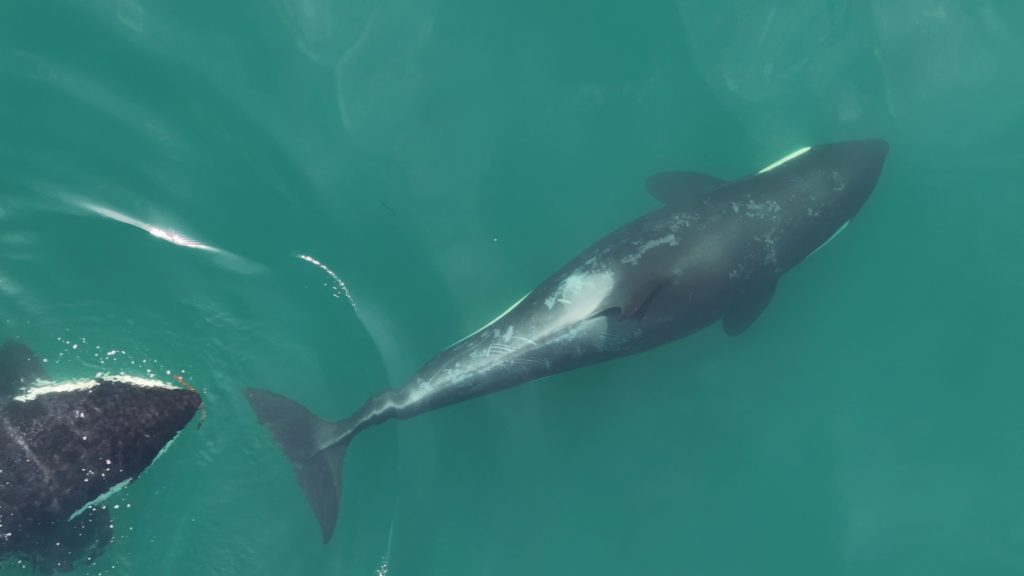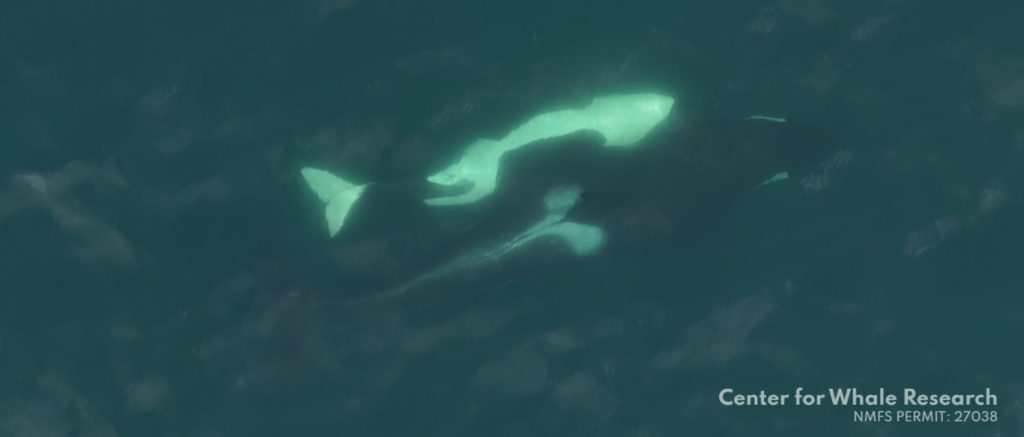Killer whales have been seen detaching lengths of seaweed and using them to massage each other - the first evidence of tool-making by marine mammals.
The whales bite off the end of a kelp stalk, position it between themselves and a partner, and roll the kelp between their bodies for prolonged periods.
Scientists spotted this behaviour in drone footage of "southern resident" killer whales in the Salish Sea, in the inland waters of Washington, USA.
Whales of all ages were seen doing this, possibly to strengthen social bonds and promote skin health.
The study was led by the Center for Whale Research (CWR), in collaboration with the University of Exeter.
"We were amazed when we first noticed this behaviour," said CWR research director Dr Michael Weiss.
Several whales species are known to engage in "kelping": moving kelp with their heads, fins and bodies - likely for play, or possibly to remove parasites and to maintain healthy skin.
But the new discovery - dubbed "allokelping" (i.e. kelping with another whale) - is different because the kelp is selected and trimmed (a "tool" deliberately made for future use) and manipulated by two whales working together.
Dr Weiss added: "Bull kelp stalk is firm but flexible, like a filled garden hose, with a slippery outer surface. I suspect these features make it an ideal grooming tool.
"What I find remarkable about this behaviour is just how widespread it is in the population.
"Males and females of all life stages and from all three southern resident pods were seen using kelp in this way. All evidence points to it being an important part of their social lives."
The team observed allokelping on 8 out of 12 days included in the study. Based on their observations, they suspect that this behaviour may be universal in this population.
Whales were most likely to pair up to allokelp with close maternal relatives, and those of similar age.
"This population of whales has been formally studied for 50 years - the best-studied orcas on the planet - and yet major new discoveries can still be made," said Rachel John, a Masters student studying Animal Behaviour at the University of Exeter.
"We hadn't noticed 'allokelping' before because the videos being collected from our previous aircraft weren't of high enough quality, but the footage we're getting now shows this behaviour in great detail."

Commenting on the possible reasons for allokelping, Professor Darren Croft, of the University of Exeter and CWR's executive director, said: "We know touch is really important.
"In primates - including humans - touch moderates stress and helps to build relationships.
"We know killer whales often make contact with other members of their group - touching with their bodies and fins - but using kelp like this might enhance this experience.
"It might also be important for skin health. Whales and dolphins have a variety of strategies to help them slough dead skin, and this may be yet another adaptation for this purpose.
"Brown algaes like bull kelp also have antibacterial and anti-inflammatory properties that may provide further benefits to the whales.
"We're now working on more research to confirm these initial findings and investigate the social and skin health benefits of this behaviour."
Other killer whales are known to rub their bodies on smooth stone beaches, possibly to remove dead skin and parasites, but the southern resident whales have not been seen doing this.
The Canadian government protects beaches where northern resident killer whales beach rub, and - with bull kelp declining due to warming water temperatures - similar protection might be needed for the southern residents.
As of CWR's last census in July of 2024, just 73 southern resident killer whales now remain. As they don't inter-breed with other killer whale populations, this number is critically low.
They feed primarily on Chinook (or "King") salmon, whose numbers have declined dramatically due to factors including overfishing, climate change, and spawning habitat destruction, including dam-building on spawning rivers. The whales are also affected by pollution and noise from human activities.
Dr Weiss said that unless major changes are made, the outlook for southern resident killer whales is "very bleak".
"We're not seeing the birth rate that's required to sustain the population. Under the status quo, all of our projections indicate the population will continue to decline" he said.
"They are struggling to find enough of the large, fatty Chinook salmon that they need to survive and successfully rear their young.
"We often think about biodiversity in terms of protecting the phenotypic variation we see in animal populations – such as differences in size, shape, and colour.
"However, conserving cultural and behavioural variation may be just as important.
"Allokelping is yet another piece of evidence of the southern residents' uniqueness.
"If we lose them, we lose so much more than 73 individual animals or a genetic lineage. We lose a complex society and a deep, unique set of cultural traditions."
Professor Croft said: "These new results highlight a potential additional threat to the future survival of the southern resident killer whales: the kelp forests where they select their grooming tools are in decline due to rising ocean temperatures associated with global warming.
"Protecting the future of these kelp forests, where the killer whales make their tools, may be important in preserving this unique culture and ensuring the southern resident killer whale population continues for generations to come."
How scientists discovered 'allokelping'

Rachel John said: "Drone cameras allow us to see things that were invisible to us from boats or the shore. I was watching one of those really close-up videos when I saw something that looked like a brown stick between two whales that were in contact with each other. We didn't think much of this at first, but we had also noticed pairs of whales staying in contact with each other for long periods - several minutes at a time. We looked back at lots of videos and realised that rubbing kelp between their bodies wasn't just a one-off thing - it was happening all the time. And once we saw whales breaking off pieces of kelp intentionally, it became clear that this is not just play - this is something important in the social lives of the 'southern resident' killer whales."
Funders of the study included the UK Natural Environment Research Council and the Orca Fund, a grantmaking fund created by Wild Fish Conservancy and administered by the Rose Foundation for Communities and the Environment.
Permission to observe this population using an unoccupied aerial vehicle (UAV) was granted by the USA National Oceanic and Atmospheric Administration.
The research team included Northeastern University, Boston, USA.
The paper, published in the journal Current Biology, is entitled: "Wild killer whales manufacture and use allogrooming tools."






